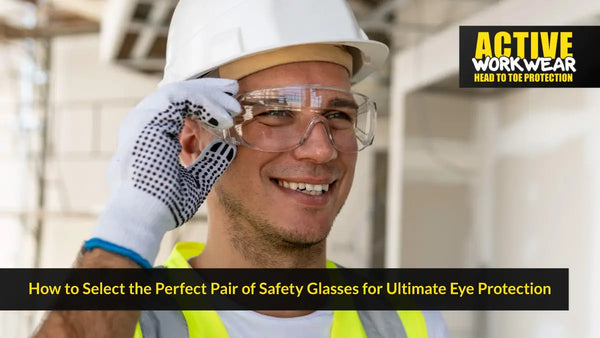How to Select the Perfect Pair of Safety Glasses for Ultimate Eye Protection
- by Mike Johnson
How to Select the Perfect Pair of Safety Glasses for Ultimate Eye Protection
Safety glasses are an essential part of personal protective equipment (PPE), offering crucial protection to your eyes against potential hazards in the workplace. The selection of the perfect pair of safety glasses for ultimate eye protection is a critical task that requires a comprehensive understanding of your work environment, the potential risks involved, and the specific features that each type of safety glasses offers.
Why is Eye Protection Important?
Safety glasses serve as the first line of defence against various workplace hazards, such as flying debris, harmful radiations, chemical splashes, and dust particles. According to the National Institute for Occupational Safety and Health, approximately 2000 workers sustain eye injuries at work every day, with about a third of these injuries requiring medical attention.
The impact of these injuries is not just physical but also financial, with a significant cost incurred due to medical expenses, lost productivity, and compensation. It's estimated that up to 90% of these injuries could be prevented or lessened with the correct use of safety eyewear.
Understanding Different Types of Safety Eyewear
Safety eyewear comes in a variety of forms, each designed to provide specific benefits and protection. The selection of the right type of safety eyewear is dependent on the nature of your job and the potential risks involved. Here are the main types of safety eyewear:
1. Full Frame Glasses: These glasses feature lenses that are surrounded by a sturdy frame, providing close fit and excellent protection in a multitude of job applications.
2. Half Frame Glasses: These glasses blend the breathability of a frameless design with the durability provided by a full frame. They are ideal for any application where both durability and an unobstructed line of vision are equally important.
3. Frameless Glasses: These glasses are lightweight and comfortable, providing unobstructed vision and are ideal for situations where comfort is a priority.
4. Safety Goggles: Goggles provide a higher level of protection compared to glasses, sealing the area around your eyes to protect against dust, splash, and impact hazards.
5. Face Shields: These offer full face protection and are typically used in conjunction with safety glasses or goggles for maximum protection against high-impact hazards, chemical splashes, or exposure to extreme heat.
Key Features to Look for in Safety Glasses
Lens Material
The material of the lens plays a crucial role in the protection level and durability of safety glasses. Common lens materials include:
1. Polycarbonate: This material offers high impact resistance and is lighter and thinner than glass or plastic. It also provides built-in resistance to harmful UV radiation.
2. Trivex: Similar to polycarbonate, Trivex offers high impact resistance and UV protection. It is lighter and has better optical clarity.
3. Glass: While heavier and less impact-resistant, glass lenses provide superior scratch resistance and optical clarity.
4. Plastic: These lenses are lighter than glass but more prone to scratches. They offer a reasonable level of impact resistance.
Lens Coatings
Lens coatings can enhance the performance and lifespan of safety glasses. Some of the common lens coatings include:
1. Anti-Fog Coating: This coating prevents the lenses from fogging up in hot or humid conditions, ensuring clear vision at all times.
2. Anti-Scratch Coating: This coating enhances the durability of the lenses by making them resistant to scratches, ensuring clear vision and extending the lifespan of the glasses.
3. Anti-UV Coating: This coating protects the eyes from harmful UV radiation, making it ideal for outdoor work environments.
4. Hard Coating: This coating provides an extra layer of protection to the lenses, making them resistant to impacts and scratches.
Lens Colour
The colour of the lens can impact visibility and comfort in different lighting conditions. Common lens colours include:
1. Clear: Offers the highest level of light transmission and is ideal for indoor or low-light conditions.
2. Grey: Reduces brightness and glare, making it suitable for outdoor work in bright sunlight.
3. Amber: Enhances contrast and depth perception, making it ideal for low-light conditions or tasks that require high attention to detail.
4. Blue: Reduces yellow light and glare, making it suitable for applications involving sodium vapour lighting.
5. Green: Reduces glare and eye strain in bright light conditions, making it suitable for prolonged outdoor work.
Fit and Comfort
The fit and comfort of safety glasses are paramount to ensure consistent use. Look for features such as adjustable temples, soft nose pads, and lightweight design to enhance comfort. Also, ensure that the glasses provide a secure fit without slipping or pinching.
Compatibility with Other PPE
In many work environments, you may need to wear safety glasses in conjunction with other PPE such as helmets, ear protection, or respiratory masks. Ensure that your chosen safety glasses are compatible with your other PPE for maximum protection and comfort.
Standards and Certifications
Safety glasses should meet the relevant safety standards and certifications to ensure optimal protection. In the UK, safety glasses should comply with the European Standard EN 166, which specifies the requirements for protective eyewear.
5 Best Safety Glasses for Indoor and Outdoor Use
PORTWEST WRAP AROUND SAFETY GLASSES/SPECTACLE-PW32
This top-selling global product boasts a straightforward yet standout design, with ultra-lightweight and flexible arms that resist breakage. The integrated lens style and moulded nose bridge promote an optimal fit for all facial shapes. This item is gender-neutral.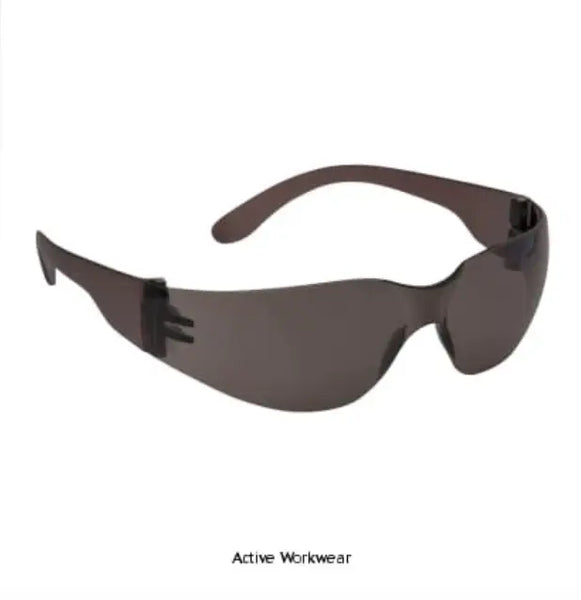

Features:
-Certified by CE standards
-Offers 99% protection from UV rays
-Enhanced durability due to anti-scratch coating
-Flexible arms for ultimate comfort
-Extremely lightweight for prolonged wear
-Comes with a complimentary spec cord
-Separately packed for vending machines
-Retail packaging increases appeal for in-store sales
-Mirror functionality suitable for both indoor and outdoor use
BOLLE (10 PAIRS) COBRA SAFETY GLASSES/GOOGLES WITH FOAM SEAL - BOCOBFSPSI
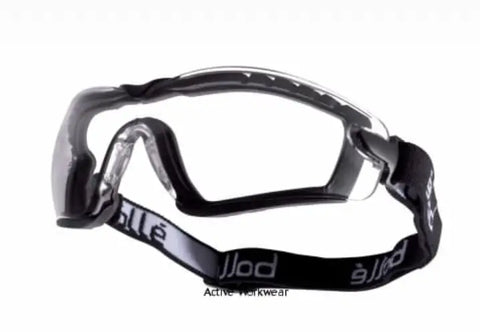
Bolle (10-Pair Set) Cobra Safety Glasses/Goggles with Foam Seal - Bocobfspsi
Features an anti-scratch, anti-fog PC Clear lens
Complies with EN 166 1.B 3 T and EN 170 standards
Extremely sleek goggle design with a soft foam seal
Broad adjustable strap
Non-slipping nose bridge
Offers a 180° panoramic field of vision.
This model of the Cobra pairs the ease of an eyeshield and the fitting tightness of goggles.
The package includes a microfiber pouch.
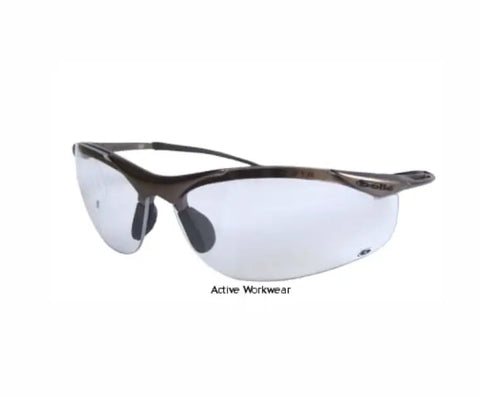
Efficiency epitomised... With a weight of just 21 grams, the lens expertise of Bolle Safety ensures protection against the risk of solid particle impact, making the Contour model indispensable. It offers more than just essential protection, it's about strength, safeguarding, style, comfort, and lightweight. Compliant with standards EN 166 and EN 172.
UVEX ULTRASONIC SAFETY GOGGLE CLEAR LENS UV9302245
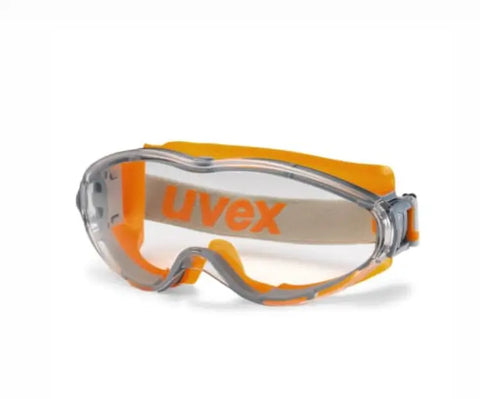
Uvex ultrasonic safety goggles are designed for a comfortable, pressure-free fit, ideal for prolonged use and can be worn over prescription glasses.
• Lightweight, sporty design akin to ski goggles.
• Features a permanent anti-fog coating on the lens interior.
• Scratch-resistant coating on the external side for extended durability.
• Soft seal that adjusts to the contours of the wearer's face.
• Goggle's soft material complements other PPE and respirators.
• Broad, fully adjustable head strap.
• Accommodates most prescription glasses.
• Replacement Lens for Ultrasonic Goggle 9302.255
• Certified to EN166 1B 349 KN standard.
ARC FLASH VISOR HELMET MOUNTED ARC PROTECTION CLASS 1 AND VLT CLASS 0 - PS90
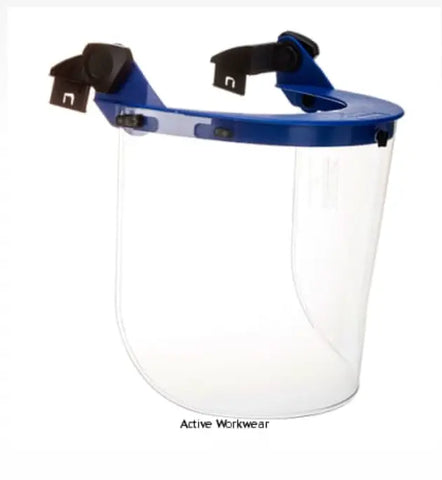
PS90 is classified as an Arc Protection Class 1 and VLT Class 0 product according to GS-ET-29 and E DIN 58118. It delivers maximum light transmission and enhanced colour recognition as defined by EN 170. This visor includes a face shield with slot-cap compatible brackets. Although it fits all Portwest hard hats, it's advisable to use it with specially approved hard hats for optimal arc flash protection at the anticipated highest level.
FEATURES
Superior protection for front and side face
Stand-off position for occasional uses
Universal slot adapter
Offers protection from 4kA electric arc flash
Designed for use with non-vented, category III helmets
CE Category III
CE certified
GS ET 29 Class 1 8-1-0
EN 166 1 B 8 3
EN 170 2C-1.2
MATERIALS
Constructed from Polycarbonate, Nylon
Selecting the perfect pair of safety glasses is a critical step towards ensuring ultimate eye protection at the workplace. By considering the nature of your job, potential hazards, and the specific features of safety glasses, you can make an informed choice that offers maximum protection and comfort. Remember, the best safety glasses are the ones that you feel comfortable wearing and, most importantly, the ones that you will wear consistently.
FREQUENTLY ASKED QUESTIONS ABOUT SAFETY GLASSES
What is safety eyeglass?
Safety eyeglasses are protective eyewear designed to shield and protect your eyes from various potential dangers or hazards. They are often used in workplaces that pose risks of eye injuries due to flying particles, splashes of corrosive liquids, intense light, or heat. Safety glasses usually encompass features such as impact-resistant lenses, wrap-around designs or side shields for greater coverage, sturdy frames, and non-slip nose bridges. They are regulated by safety standards, ensuring certain levels of protection. Some safety glasses also come with prescription lenses for individuals requiring vision correction.
What are the uses of safety glasses and goggles?
Safety glasses and goggles are used in a variety of contexts and professions to safeguard the wearer's eyes from potential hazards. Here are some of their key uses:
1. Industrial Work: Often used in manufacturing, construction, and chemical industries where there's a risk of flying debris, sparks, dust, chemical splashes, or intense light and heat.
2. Medical Settings: Doctors, nurses, and laboratory technicians use safety glasses and goggles to protect against biohazards, chemical splashes, and infectious fluids.
3. Sports and Recreation: They're used in various sports, from racquetball to shooting, to protect against flying objects and intense lighting.
4. Science Labs: Students and professionals in scientific research labs use safety glasses or goggles to protect against chemical splashes and harmful light exposure.
5. Woodworking and Carpentry: They protect against flying wood particles, dust, and intense light reflection from surfaces.
6. Welding and Metal Work: Specialised types shield from the intense light and sparks generated by welding.
7. In Gardening and Lawn Care: They help protect against harmful UV rays, dust, and debris when mowing or trimming hedges.
8. Prescription Use: Safety glasses equipped with prescription lenses help those with vision disorders to see clearly while protecting their eyes in hazardous environments.
9. Home Use: They're used during home improvement or DIY projects like painting, drilling, or cleaning with chemicals.
Why is eye and face protection important?
Eye and face protection is crucial because the eyes and face are some of the most sensitive and vulnerable parts of our bodies. A minor injury can lead to severe, sometimes irreversible, damage. Here are some reasons why their protection is important:
1. Protects from Physical Injuries: Safety glasses or goggles can protect your eyes from foreign bodies like dust particles, metal chips, wood chips, and more that could cause scratches or punctures.
2. Shields from Chemicals: When handling chemicals, there's always a risk of splashes, even with careful use. Protective eyewear can shield your eyes from potential chemical burns and reactions.
3. Guards Against Harmful Rays: Certain work conditions, like welding, might expose workers to dangerous radiation. This can cause severe eye damage, including retinal burns and cataracts. Specialized protective eyewear can shield against these harmful rays.
4. Prevents Contamination: In a healthcare or laboratory context, protective eyewear prevents the spread of infectious diseases and protects against biohazards.
5. Reduces Risk of Blindness: Eye injuries can potentially lead to partial or complete loss of vision. Using eye and face protection reduces this risk significantly.
6. Enhances Productivity: By providing a safer work environment, eye and face protection can lead to improved productivity and efficiency.
7. Compliance with Regulations: In many industries, safety regulations necessitate the use of eye and face protection to ensure the safety of workers.
Remember, prevention is always better than cure. Even minor eye or face injuries can cause significant discomfort and disruption, so protection is vital.
How strong are safety glasses?
Safety glasses are exceptionally strong due to the materials used in their creation and the strict manufacturing standards they must adhere to. Their lenses are commonly made from polycarbonate, a highly durable material that's up to 10 times more impact-resistant than regular glass or plastic.
All safety glasses must meet specific international safety standards, such as those set by the American National Standards Institute (ANSI) or European Standards (EN). For instance, to receive ANSI Z87.1 certification, safety glasses have to pass stringent tests, including a high mass impact test where a pointed 500g (1.1 lb) weight is dropped onto the lenses from a height of 127 cm (50 inches). Lenses must also survive a high-velocity test in which they are hit by a steel ball travelling at a speed of 150 feet/second (102 mph).
However, while safety glasses' strength is extraordinary, it does not make them completely indestructible. They should be properly cared for and replaced when they show signs of damage or excessive wear to ensure they provide the needed protection.
What happens if you don't wear safety glasses?
Not wearing safety glasses in environments where they're required can lead to serious consequences for your eyes and vision. Here's what could happen if you choose not to use safety glasses when necessary:
1. Eye Injuries: You expose your eyes to potential injuries from flying objects, particles, tools, or other hazardous materials that could cause scratches, perforations or damage to the eye.
2. Chemical Exposure: If you work in a lab or with harmful substances, chemicals could splash into your eyes, potentially damaging your vision or causing severe pain.
3. UV Exposure: If you're working outdoors or with welding equipment, your eyes could be exposed to harmful UV rays that can lead to conditions like photokeratitis (essentially sunburn of the eye) or long-term cataract development.
4. Infectious Disease: In a medical or biological setting, lack of eye protection could increase risk of infection from splashes of body fluids.
5. Long-term Damage: Without proper protection over time, you may experience long-term and possibly permanent damage to your vision.
6. Legal Repercussions: Many workplaces legally require the use of safety glasses in hazardous environments. If you're found not to be wearing them, it could lead to legal consequences like fines, job loss, or liability in case of an accident.
7. Financial Cost: The cost of treating eye injuries can be substantial, and this doesn't take into account potential lost wages due to time off work.
Remember, safety glasses are an integral part of personal protective equipment (PPE) and should always be used as directed.

